2014

|
Chen, K., Kimmel, R., Bartholomew, A., Ponto, K., Gleicher, M., and Radwin, R. , “Manually
locating physical and virtual reality objects” Human Factors, (2014) In Print. PrePrint
Ponto, K., Chen, K., Tredinnick, R., Radwin, R., “Assessing Exertions: How an increased level
of immersion unwittingly leads to more natural behavior” IEEE Conference on Virtual Reality 2014,
Minneapolis, MN. March 29 - April 2, 2014. PrePrint
Subramaniam, N.A., and Ponto, K., “Hierarchical Plane Extraction (HPE): An Efficient Method For
Extraction Of Planes From Large Pointcloud Datasets” Proceedings of ACADIA 2014, In Print. PrePrint
Chen, K., Ponto, K., Sesto, M.,and Radwin, R.G.„ “Influence of altered visual feedback on neck movement
for a virtual reality rehabilitative system” Proceedings of the Human Factors and Ergonomics,
(2014) pp. 693-697.
|
2013

|
Ponto, K., Gleicher, M., Radwin, R., and Shin, H.J., “Perceptual Calibration for Immersive Display
Environments” IEEE Transactions on Visualization and Computer Graphics, (2013) v. 19, n. 4, pp.
691-700. PrePrint
Brennan, P.F., Ponto, K., Radwin, R., and Kreutz, K., “Envisioning the future of home care: applications
of immersive virtual reality” Studies in health technology and informatics, (2013) v. 192, n.
1, pp. 599-602. PubMed
Radwin, R.G., Chen, K., Ponto, K., and Tredinnick, R, “Virtual Exertions Physical Interactions
in a Virtual Reality CAVE for Simulating Forceful Tasks” Proceedings of the Human Factors and
Ergonomics, (2013) pp. 967-971. PrePrint
Brennan, P. F., Nicolalde, D. F., Ponto, K., Kinneberg, M., Freese, V., and Paz, D, “Cultivating
Imagination: Development and Pilot Test of a Therapeutic Use of an Immersive Virtual Reality CAVE”
In AMIA Annual Symposium Proceedings, (2013) vol. 2013, p. 135. PubMed
Kimball, J., Ponto, K., Wypych, T., and Kuester, F., “RSVP: Ridiculously Scalable Video Playback
on Clustered Tiled Displays” IEEE ISM 2013, (2013) pp. 9-16. PrePrint
Huynh, A., Ponto, K., Yu-Min, A., and Kuester, F., “Visual analytics of inherently noisy crowdsourced
data on ultra high resolution displays” In proceedings of IEEE Aerospace Conference, (2013) pp. 1-8.
Ponto, K., Tredinnick, R., Bartholomew, A., Roy, C., Szafir, D., Greenheck, D., and Kohlmann, J.,
“SculptUp: A Rapid, Immersive 3D Modeling Environment” 3D User Interfaces (3DUI), 2013 IEEE
Symposium on, (2013) pp. 199-200. PrePrint
Tredinnick, R. and Ponto, K., “Say It To See It: A Speech Based Immersive Model Retrieval System”
3D User Interfaces (3DUI), 2013 IEEE Symposium on, Orlando, Florida. March 16-17, 2013. PrePrint
|
2012

|
Ponto, K., Shin, H.J., Kohlmann, J., and Gleicher, M., “Online Real-Time Presentation of Virtual Experiences
for External Viewers” Proceedings of the 18th ACM Symposium on Virtual Reality Software
and Technology, (2012) pp. 45-52.
Ponto, K., Kohlmann, J., and Gleicher, M. Effective Replays and Summarization of Virtual Experiences. (2012) Accepted for publication in proceedings of IEEEVR 2012 and IEEE
Transactions on Visualization and Computer Graphics. PrePrint
Ponto, K., Kimmel, R., Kohlmann, J., Bartholomew, A., and Radwin, R. Virtual
Exertions: a user interface combining visual information, kinesthetics and biofeedback
for virtual object manipulation. (2012) Accepted for proceedings in 3DUI 2012. PrePrint |
2011

|
Ponto, K. Doerr, K. Kooker, J., Wypych, T., and Kuester, F. CGLXTouch: A multi-user
multi-touch approach for ultra-high-resolution collaborative workspaces. Future
Generation Computer Systems. (2011) v. 27 n. 6 pp. 649-656. PrePrint
Yamaoka, S., Ponto, K., Doerr, K., and Kuester, F. Interactive Image Fusion in
Distributed Visualization Environments. In proceedings of IEEE Aerospace Conference.
(2011) pp. 1-7.
Wypych, T., Yamaoka, S., Ponto, K., and Kuester F. System for Inspection of Large High-
Resolution Radiography Datasets. In proceedings of IEEE Aerospace Conference. (2011)
pp. 1-9.
He, Z., Ponto, K., and Kuester, F. Collaborative Visual Analytics Environment for
Imaging Genetics. Collaborative Computational Technologies for Biomedical Research.
(2011) pp. 467-490. |
2010
 |
Ponto, K., Doerr, K. and Kuester, F. Giga-Stack: A Method for Visualizing Giga-pixel
Layered Imagery on Massively Tiled Displays. Future Generation Computer Systems.
(2010) v. 26, n. 5, pp. 693-700. Thesis Chapter
Ponto, K. and Kuester, F. DIGI-Vis: Distributed Interactive Geospatial Information
Visualization. In proceedings of IEEE Aerospace Conference. (2010) pp. 1-7. Thesis Chapter
Ponto, K. Building a foundation for human centric multi-dimensional data analysis. Ph.D. Dissertation. University of California, San Diego. 2010.
DeFanti, T., Acevedo, D., Ainsworth, R., Brown, M., Cutchin, S., Dawe, G., Doerr, K.,
Johnson, A., Knox, C., Kooima, R., Kuester, F., Leigh, J., Long, L.,Otto, P., Petrovic, V.,
Ponto, K., Prudhomme, A., Rao, R., Renambot, L., Sandin, D., Schulze, J., Smarr, L.,
Srinivasan, M., Weber, and P., Wickham, G. The future of the CAVE. Central European
Journal of Engineering. (2010). pp. 1-22. PrePrint
Olsen, M.J. , Ponto, K., Kimball, J., Seracini, M., and Kuester, F. 2D open-source editing
techniques for 3D laser scans. In proceedings of CAA’2010 (2010). p. 47-50. PrePrint
Seracini, M., Kuester, F., De Vita, M., Olsen, M.J., Ponto, K., Kimball, J., Corazzini, S.,
and Bonini, C. Alla riscoperta di Palazzo Medici Riccardi, Campagna di indagini
diagnostiche per lo studio e la caratterizzazione dell’ evoluzuione architettonica del
monumento [In English: “Rediscovering Palazzo Medici Riccardi. Diagnostic
Investigation to Study and Characterize the Monument’s Architectural Evolution”].
(2010) pp. 241-249. |
2009
 |
Ponto, K., Seracini, M., and Kuester, F. Wipe-Off: an intuitive interface for exploring
ultra-large multi-spectral data sets for cultural heritage diagnostics. Computer Graphics
Forum (2009) v. 28, n. 8, pp. 2291-2301.
Ponto, K., Wypych, T., Doerr, K., Yamaoka, S., Kimball, J., and Kuester, F. VideoBlaster: a distributed, low-network bandwidth method for multimedia playback on
tiled display systems. In proceeding of IEEE International Symposium on Multimedia.
(2009) pp. 201-206. Thesis Chapter |
2008
 |
| Ponto, K., Kuester, F., Nideffer, R. and Penny, S. Tangled Reality. Virtual Reality.
(2008) v. 12 n. 1 pp. 37-45. |
2006
 |
Ponto, K. Entangled Realities. Master’s Thesis. University of California, Irvine. 2006.
Ponto, K., Kuester, F., Nideffer, R. and Penny, S. Virtual Bounds: a teleoperated mixed
reality. Virtual Reality. (2006) v. 10 n. 1 pp. 41-47. PrePrint |
Selected Publications

| Virtual Bounds: a teleoperated mixed reality |
|
| Abstract: This paper introduces a mixed reality workspace that allows users to combine physical and computer-generated artifacts, and to control and simulate them within one fused world. All interactions are captured, monitored, modeled and represented with pseudo-real world physics. The objective of the presented research is to create a novel system in which the virtual and physical world would have a symbiotic relationship. In this type of system, virtual objects can impose forces on the physical world and physical world objects can impose forces on the virtual world. Virtual Bounds is an exploratory study allowing a physical probe to navigate a virtual world while observing constraints, forces, and interactions from both worlds. This scenario provides the user with the ability to create a virtual environment and to learn to operate real-life probes through its virtual terrain.
Link: Ponto, K., Kuester, F., Nideffer, R. and Penny, S. Virtual Bounds: a teleoperated mixed reality. Virtual Reality. (2006) v. 10, n. 1, pp. 41-47. |
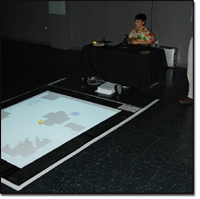 |
| Tangled Reality |
| Abstract: This paper introduces a mixed reality workspace that allows users to combine physical and computer-generated artifacts, and to control and simulate them within one fused world. All interactions are captured, monitored, modeled and represented with pseudo-real world physics. The objective of the presented research is to create a novel system in which the virtual and physical world would have a symbiotic relationship. In this type of system, virtual objects can impose forces on the physical world and physical world objects can impose forces on the virtual world. Virtual Bounds is an exploratory study allowing a physical probe to navigate a virtual world while observing constraints, forces, and interactions from both worlds. This scenario provides the user with the ability to create a virtual environment and to learn to operate real-life probes through its virtual terrain.
Link: Ponto, K., Kuester, F., Nideffer, R. and Penny, S. Tangled Reality. Virtual Reality. (2008) v. 12, n. 1, pp. 37-45.
|
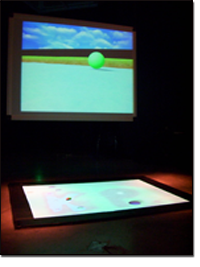 |
| Wipe-Off: an intuitive interface for exploring ultra-large multi-spectral data sets for cultural heritage diagnostics |
| Abstract: A visual analytics technique for the intuitive, hands-on analysis of massive, multi-dimensional and multi-variate data is presented. This multi-touch-based technique introduces a set of metaphors such as wiping, scratching, sandblasting, squeezing and drilling, which allow for rapid analysis of global and local characteristics in the data set, accounting for factors such as gesture size, pressure and speed. A case study is provided for the analysis of multi-spectral image data of cultural artefacts. By aligning multi-spectral layers in a stack, users can apply different multi-touch metaphors to investigate features across different wavelengths. With this technique, flexibly definable regions can be interrogated concurrently without affecting surrounding data.
Link: Ponto, K., Seracini, M., and Kuester, F. Wipe-Off: an intuitive interface for exploring ultra-large multi-spectral data sets for cultural heritage diagnostics. Computer Graphics Forum (2009) v. 28, n. 8, pp. 2291-2301. |
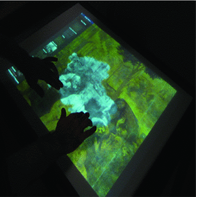 |
| VideoBlaster: a distributed, low-network bandwidth method for multimedia playback on tiled display systems |
| Abstract: Tiled display environments present opportune workspaces for displaying multimedia content. Often times, displaying this kind of audio/visual information requires a substantial amount of network bandwidth. In this paper we present a method for distributing the decoding over the entire display environment, allowing for substantially less network overhead. This method also allows for interactive configuration of the visual workspace. The method described scales independently of video frame size and produces lower latency compared to streaming approaches.
Link: Ponto, K. Wypych, T. Doerr, K. Yamaoka, S. Kimball, J. Kuester, F. VideoBlaster: a distributed, low-network bandwidth method for multimedia playback on tiled display systems. In proceeding of IEEE International Symposium on Multimedia. (2009) pp. 201-206. |
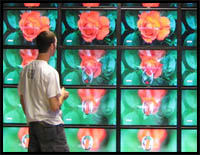 |
| Giga-Stack: A Method for Visualizing Giga-pixel Layered Imagery on Massively Tiled Displays |
| Abstract: In this paper, we present a technique for the interactive visualization and interrogation of multi-dimensional giga-pixel imagery. Co-registered image layers representing discrete spectral wavelengths or temporal information can be seamlessly displayed and fused. Users can freely pan and zoom, while swiftly transitioning through data layers, enabling intuitive analysis of massive multi-spectral or time-varying records. A data resource aware display paradigm is introduced which progressively and adaptively loads data from remote network attached storage devices. The technique is specifically designed to work with scalable, high-resolution, massively tiled display environments. By displaying hundreds of mega-pixels worth of visual information all at once, several users can simultaneously compare and contrast complex data layers in a collaborative environment.
Link: Ponto, K., Doerr, K. and Kuester, F. Giga-Stack: A Method for Visualizing Giga-pixel Layered Imagery on Massively Tiled Displays. Future Generation Computer Systems. (2010) v. 26, n. 5, pp. 693-700. |
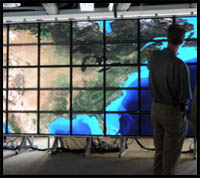 |
| DIGI-Vis: Distributed Interactive Geospatial Information Visualization |
| Abstract: Geospatial information systems provide an abundance of information for researchers and scientists. Unfortunately this type of data can usually only be analyzed a few megapixels at a time, giving researchers a very narrow view into these voluminous data sets. We propose a distributed data gathering and visualization system that allows researchers to view these data at hundreds of megapixels simultaneously. This system allows scientists to view real-time geospatial information at unprecedented levels expediting analysis, interrogation, and discovery.
Link: Ponto, K. and Kuester, F. DIGI-Vis: Distributed Interactive Geospatial Information Visualization. In proceedings of IEEE Aerospace Conference. (2010) pp. 1-7. |
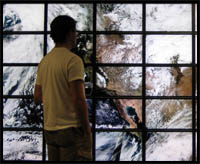 |
| CGLXTouch: A multi-user multi-touch approach for ultra-high-resolution collaborative workspaces |
| Abstract: This paper presents an approach for empowering collaborative workspaces through ultra-high-resolution tiled display environments concurrently interfaced by multiple multi-touch devices. Multi-touch table devices are supported along with portable multi-touch tablet and phone devices, which can be added to and removed from the system on the fly. Events from these devices are tagged with a device id and are synchronized with the distributed display environment enabling multi-user support. As portable devices are not equipped to render content directly, a rendered viewpoint is streamed in. The presented approach scales for large numbers of devices, providing a multitude of hands-on techniques for collaborative data analysis.
Link: Ponto, K., Doerr, K., Wypych, T., Kooker, J., and Kuester, F. CGLXTouch: A multi-user multi-touch approach for ultra-high-resolution collaborative workspaces. Future Generation Computer Systems, In Press |
 |
|